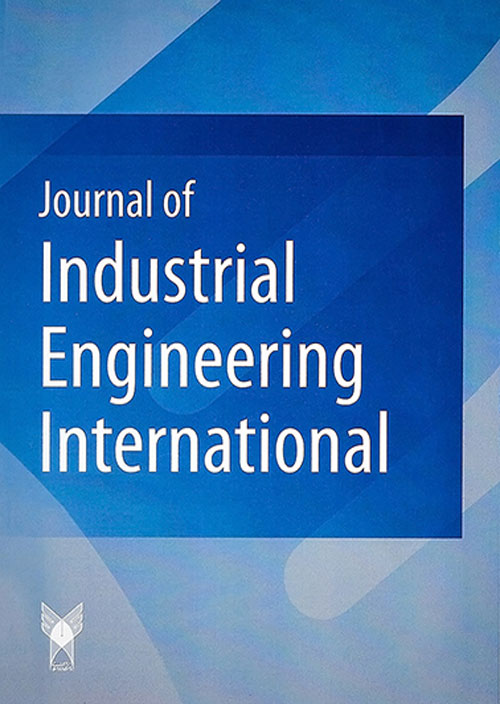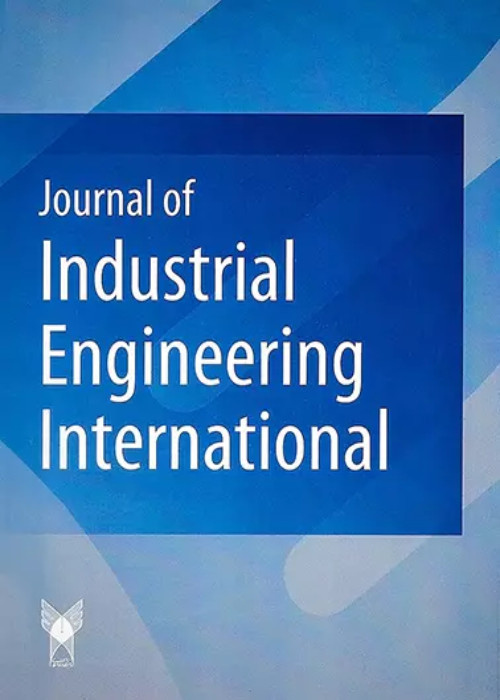فهرست مطالب

Journal Of Industrial Engineering International
Volume:13 Issue: 3, Summer 2017
- تاریخ انتشار: 1396/06/10
- تعداد عناوین: 10
-
-
Pages 275-296
Assembly plays an important role in any production system as it constitutes a significant portion of the lead time and cost of a product. Virtual computer-integrated manufacturing (VCIM) system is a modern production system being conceptually developed to extend the application of traditional computer-integrated manufacturing (CIM) system to global level. Assembly scheduling in VCIM systems is quite different from one in traditional production systems because of the difference in the working principles of the two systems. In this article, the assembly scheduling problem in VCIM systems is modeled and then an integrated approach based on genetic algorithm (GA) is proposed to search for a global optimised solution to the problem. Because of dynamic nature of the scheduling problem, a novel GA with unique chromosome representation and modified genetic operations is developed herein. Robustness of the proposed approach is verified by a numerical example.
Keywords: Optimisation, Assembly scheduling, Hard precedence constraint, Virtual computer -integrated manufacturing -
Pages 297-306
In the literature, the application of multi-objective dynamic scheduling problem and simple priority rules are widely studied. Although these rules are not efficient enough due to simplicity and lack of general insight, composite dispatching rules have a very suitable performance because they result from experiments. In this paper, a dynamic flexible flow line problem with sequence-dependent setup times is studied. The objective of the problem is minimization of mean flow time and mean tardiness. A 0–1 mixed integer model of the problem is formulated. Since the problem is NP-hard, four new composite dispatching rules are proposed to solve it by applying genetic programming framework and choosing proper operators. Furthermore, a discrete-event simulation model is made to examine the performances of scheduling rules considering four new heuristic rules and the six adapted heuristic rules from the literature. It is clear from the experimental results that composite dispatching rules that are formed from genetic programming have a better performance in minimization of mean flow time and mean tardiness than others.
Keywords: Scheduling, Dynamic flexible flow line, Simulation, Heuristics, Genetic programming -
Pages 307-322
Endpoint detection is very important undertaking on the side of getting a good understanding and figuring out if a plasma etching process is done in the right way, especially if the etched area is very small (0.1%). It truly is a crucial part of supplying repeatable effects in every single wafer. When the film being etched has been completely cleared, the endpoint is reached. To ensure the desired device performance on the produced integrated circuit, the high optical emission spectroscopy (OES) sensor is employed. The huge number of gathered wavelengths (profiles) is then analyzed and pre-processed using a new proposed simple algorithm named Spectra peak selection (SPS) to select the important wavelengths, then we employ wavelet analysis (WA) to enhance the performance of detection by suppressing noise and redundant information. The selected and treated OES wavelengths are then used in modified multivariate control charts (MEWMA and Hotelling) for three statistics (mean, SD and CV) and windowed polynomial regression for mean. The employ of three aforementioned statistics is motivated by controlling mean shift, variance shift and their ratio (CV) if both mean and SD are not stable. The control charts show their performance in detecting endpoint especially W-mean Hotelling chart and the worst result is given by CV statistic. As the best detection of endpoint is given by the W-Hotelling mean statistic, this statistic will be used to construct a windowed wavelet Hotelling polynomial regression. This latter can only identify the window containing endpoint phenomenon.
Keywords: Plasma etch process, Endpoint detection, Multivariate control charts, Monitoring profiles, Windowed regression -
Pages 323-330
The vehicle routing problem with the capacity constraints was considered in this paper. It is quite difficult to achieve an optimal solution with traditional optimization methods by reason of the high computational complexity for large-scale problems. Consequently, new heuristic or metaheuristic approaches have been developed to solve this problem. In this paper, we constructed a new heuristic algorithm based on the tabu search and adaptive large neighborhood search (ALNS) with several specifically designed operators and features to solve the capacitated vehicle routing problem (CVRP). The effectiveness of the proposed algorithm was illustrated on the benchmark problems. The algorithm provides a better performance on large-scaled instances and gained advantage in terms of CPU time. In addition, we solved a real-life CVRP using the proposed algorithm and found the encouraging results by comparison with the current situation that the company is in.
Keywords: (Capacitated vehicle routing problem (CVRP), Tabu search, Adaptive large neighborhood search (ALNS -
Pages 331-345
To access the efficient inventory system, managers should consider all the situations that have happened in reality. One of these situations is the presence of the defective items in each received lot and the other situation is being the group of customers that do not wait to fulfill their requirements from the vendor and choose another one to get their orders so the proportion of the backordered items becomes lost sales. In this paper we consider both mentioned situations simultaneously to model the inventory system while the proportion of backordering is constant and the imperfect rate follows a uniform distribution, also the particular sampling process is considered that is explained in detail in "Problem definition". Our purpose in this paper is to access the optimum value for the total revenue in a year by a particular solution method that is provided in "Solution method". After these sections we provide the numerical results in "Numerical result" to show the effect of sensitive parameters on the decision variables and the total profit.
Keywords: Inventory system, Imperfect items, Partial backordering, Inspection -
Pages 347-355
Automobile sector forms the backbone of manufacturing sector. Vehicle assembly line is important section in automobile plant where repetitive tasks are performed one after another at different workstations. In this thesis, a methodology is proposed to reduce cycle time and time loss due to important factors like equipment failure, shortage of inventory, absenteeism, set-up, material handling, rejection and fatigue to improve output within given cost constraints. Various relationships between these factors, corresponding cost and output are established by scientific approach. This methodology is validated in three different vehicle assembly plants. Proposed methodology may help practitioners to optimize the assembly line using lean techniques.
Keywords: Simulation, Optimization, Lean, Mathematical modeling, Line balancing, Output, Utilization, Efficiency, Cost constraint, Downtime -
Pages 357-367
Currently, many socially responsible governments adopt economic incentives and deterrents to manage environmental impacts of electricity suppliers. Considering the Stackelberg leadership of the government, the government’s role in the competition of power plants in an electricity market is investigated. A one-population evolutionary game model of power plants is developed to study how their production strategy depends on tariffs levied by the government. We establish that a unique evolutionary stable strategy (ESS) for the population exists. Numerical examples demonstrate that revenue maximization and environment protection policies of the government significantly affect the production ESS of competitive power plants. The results reveal that the government can introduce a green energy source as an ESS of the competitive power plants by imposing appropriate tariffs.
Keywords: Evolutionary game theory, Green electricity, Power plant, Government intervention, Energy source selection -
Pages 369-380
This paper considers the comparison of twoðs; SÞ production inventory systems with retrials of unsatisfiedcustomers. The time for producing and adding eachitem to the inventory is exponentially distributed with rateb. However, a production rate ab higher than b is used atthe beginning of the production. The higher production ratewill reduce customers’ loss when inventory level approacheszero. The demand from customers is according to aPoisson process. Service times are exponentially distributed.Upon arrival, the customers enter into a buffer offinite capacity. An arriving customer, who finds the bufferfull, moves to an orbit. They can retry from there and interretrialtimes are exponentially distributed. The two modelsdiffer in the capacity of the buffer. The aim is to find theminimum value of total cost by varying different parametersand compare the efficiency of the models. The optimumvalue of a corresponding to minimum total cost is animportant evaluation. Matrix analytic method is used tofind an algorithmic solution to the problem. We also provideseveral numerical or graphical illustrations.
Keywords: Production inventory, Buffer, Retrial, Matrix analytic method, Cost analysis -
Pages 381-391
In this paper we develop an inventory model, to determine the optimal ordering quantities, for a set of two substitutable deteriorating items. In this inventory model the inventory level of both items depleted due to demands and deterioration and when an item is out of stock, its demands are partially fulfilled by the other item and all unsatisfied demand is lost. Each substituted item incurs a cost of substitution and the demands and deterioration is considered to be deterministic and constant. Items are order jointly in each ordering cycle, to take the advantages of joint replenishment. The problem is formulated and a solution procedure is developed to determine the optimal ordering quantities that minimize the total inventory cost. We provide an extensive numerical and sensitivity analysis to illustrate the effect of different parameter on the model. The key observation on the basis of numerical analysis, there is substantial improvement in the optimal total cost of the inventory model with substitution over without substitution.
Keywords: Inventory control, Substitutable items, Cost ofSubstitution, Deterioration, Optimal ordering quantity, Joint replenishment -
Pages 393-416
Lead time is one of the major limits that affect planning at every stage of the supply chain system. In this paper, we study a continuous review inventory model. This paper investigates the ordering cost reductions are dependent on lead time. This study addressed two-echelon supply chain problem consisting of a single vendor and a single buyer. The main contribution of this study is that the integrated total cost of the single vendor and the single buyer integrated system is analyzed by adopting two different (linear and logarithmic) types ordering cost reductions act dependent on lead time. In both cases, we develop effective solution procedures for finding the optimal solution and then illustrative numerical examples are given to illustrate the results. The solution procedure is to determine the optimal solutions of order quantity, ordering cost, lead time and the number of deliveries from the single vendor and the single buyer in one production run, so that the integrated total cost incurred has the minimum value. Ordering cost reduction is the main aspect of the proposed model. A numerical example is given to validate the model. Numerical example solved by using Matlab software. The mathematical model is solved analytically by minimizing the integrated total cost. Furthermore, the sensitivity analysis is included and the numerical examples are given to illustrate the results. The results obtained in this paper are illustrated with the help of numerical examples. The sensitivity of the proposed model has been checked with respect to the various major parameters of the system. Results reveal that the proposed integrated inventory model is more applicable for the supply chain manufacturing system. For each case, an algorithm procedure of finding the optimal solution is developed. Finally, the graphical representation is presented to illustrate the proposed model and also include the computer flowchart in each model.
Keywords: Operations research, Inventory model, Continuous review system, Ordering cost reduction, Lead time crashing cost


